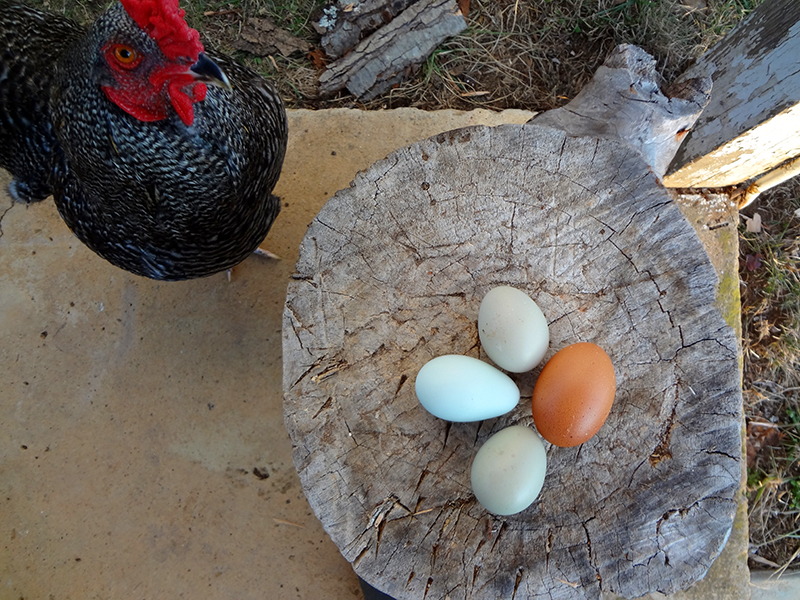February 26th, 2014 §
Just as I was going to write about how it was 65 degrees and sunny this past weekend, and that the maples are budding bright red, the winter weeds are blooming, and the male red-winged blackbirds have reappeared from their wintering grounds, another polar vortex dipped south.
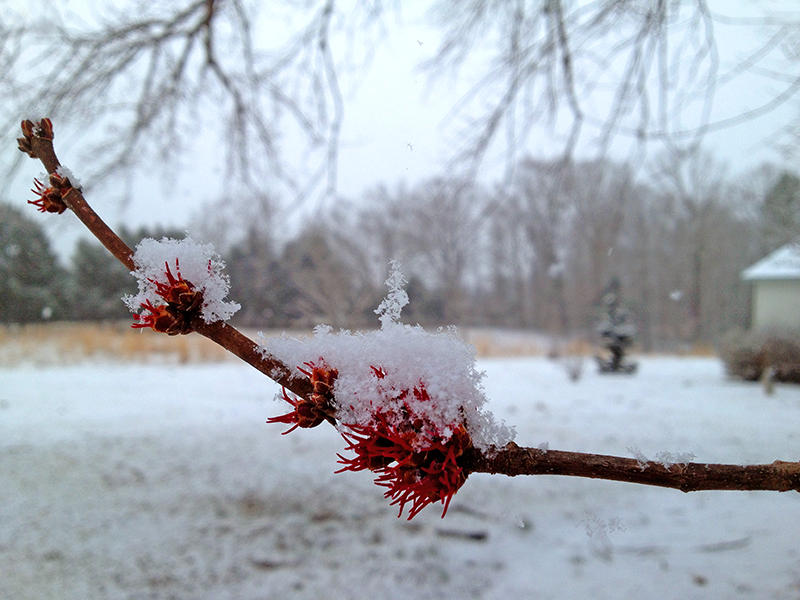
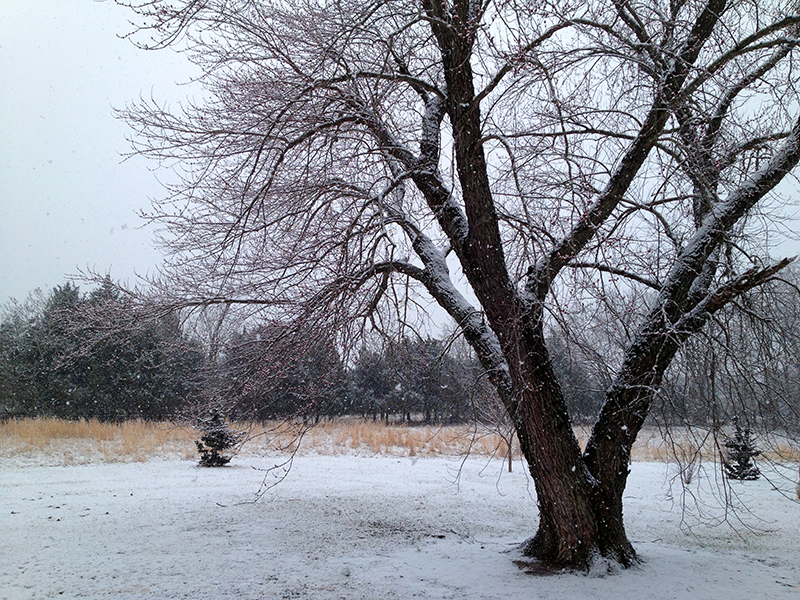
I’ve awoken to snow two mornings in a row. Not much accumulation is expected, but it’s enough to remind me that we’re still at least a month away from spring.
February 21st, 2014 §
When hours in front of the wood stove leave me feeling parched and sleepy, I like to take a walk to my nearest body of wild water. I head down the hill to the creek that runs along the back of my property. I have a relationship with this part of the farm only during winter. From March to about November the brambles grow so thickly that the woods are close to impenetrable, as well as being distressingly thick with ticks.
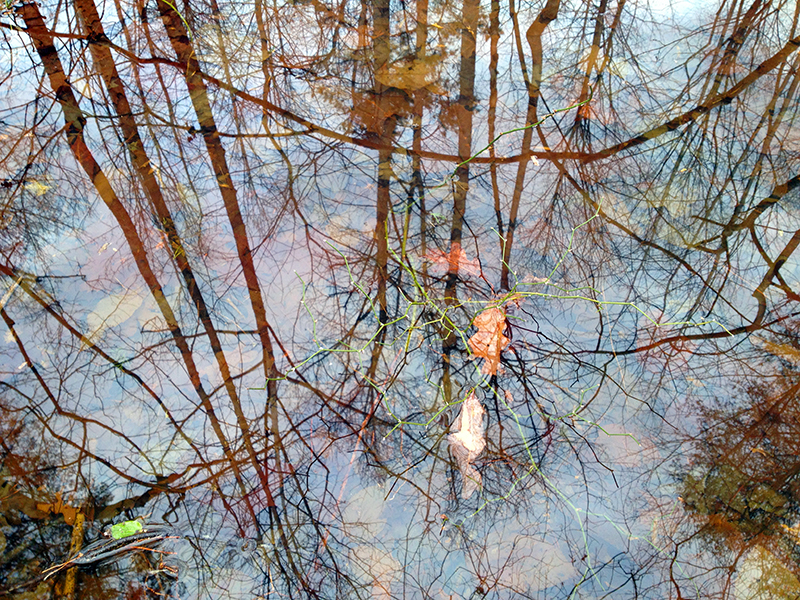
Walks to the creek in winter remind me of being a kid growing up playing in the woods and streams. Today the mineral smell of standing water and boggy decomposition flung me right back to being ten years old and scooping gelatenous masses of polywog eggs out of still water. The clumps broke apart and slimed my hands as I dropped them into a bucket of water before toting the survivors home to hatch in a fish tank in the garage.
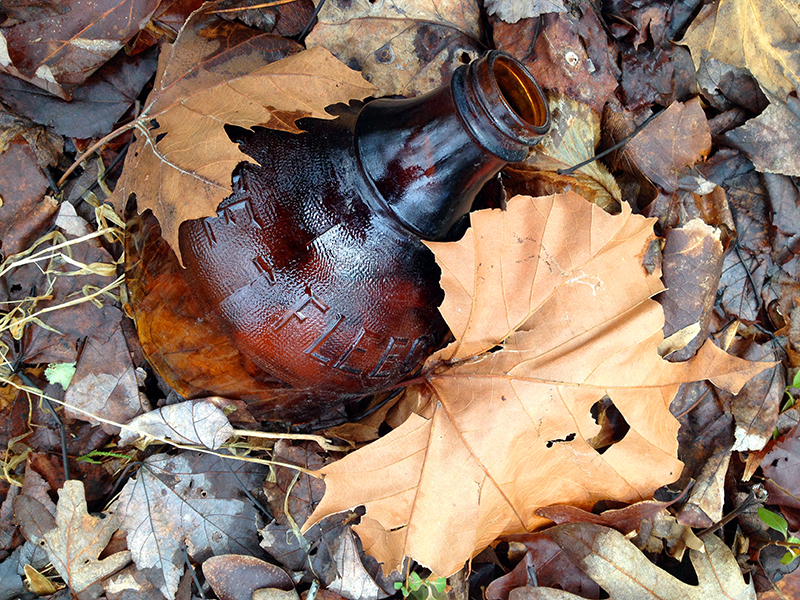
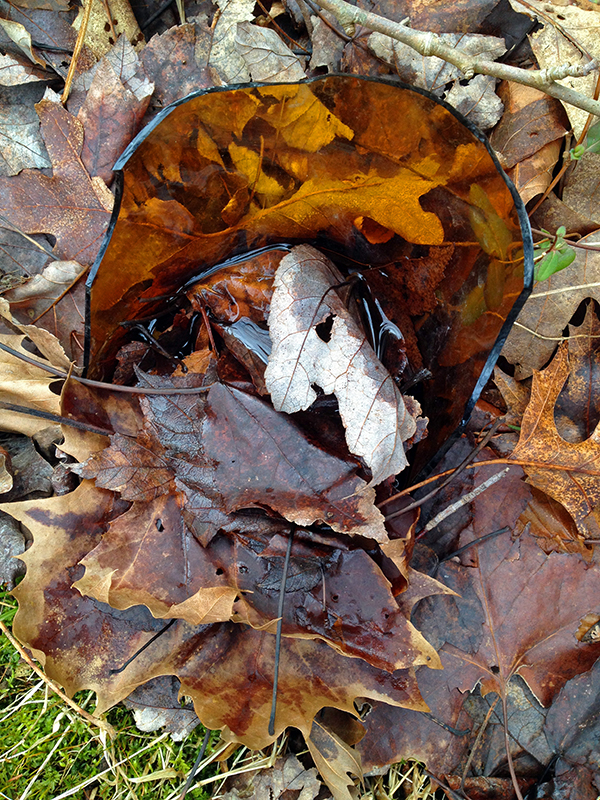
I always find some sort of treasure, usually old broken bottles, mostly of the hootch-holding variety. Today I found an amber jug with the words “white fleece” around its top. Nearby was the bottom of the bottle. I looked online but couldn’t trace the bottle’s provenance. The name make me think of fabric softener—but did that ever come packaged in amber jugs? A mystery for sure.

The sound of the creek relaxes me—some day I’ve love to live near moving fresh water—and I like to walk up the creek in my wellies and feel the current against my feet and legs. Today the water was fast and churning grey from our recent snowmelt and rain.
I have happy memories of the creek being the site of my first adventures with Tucker. When he was a tiny pup we’d walk down there, him absorbing the important lessons of following and staying close to me that have made him such an excellent off-leash trail dog. He’d stop and sniff stumps, memorizing the scents of the native foxes and beginning to understand his territorial responsibilities. I’d coax him up and over fallen trees—massive obstacles to legs just a few inches long—him gaining confidence and learning to trust that I wouldn’t hurt or put him in danger. Trips to the creek laid a good foundation for our partnership.
Eventually I restricted Tuck’s range to within sight of the homestead when I installed his invisible fence. He still has acres to patrol, but his winter visits to the creek are now just memories.
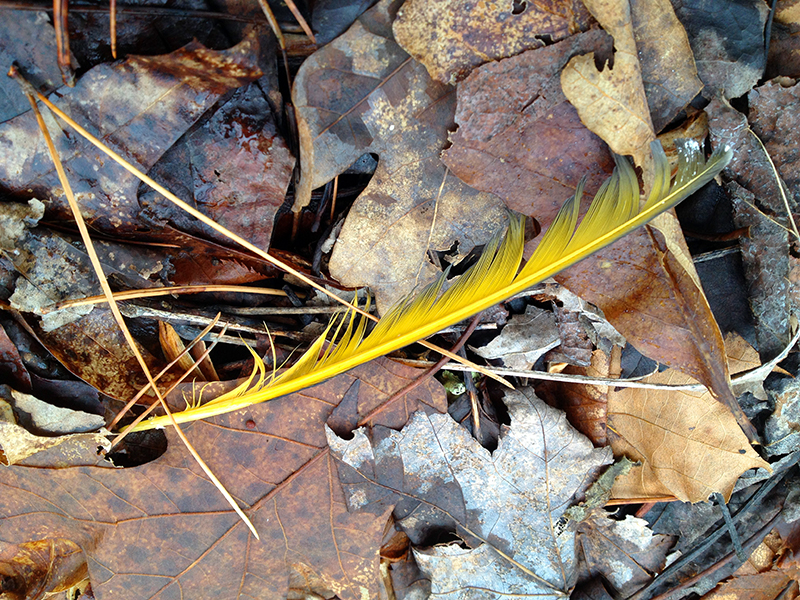
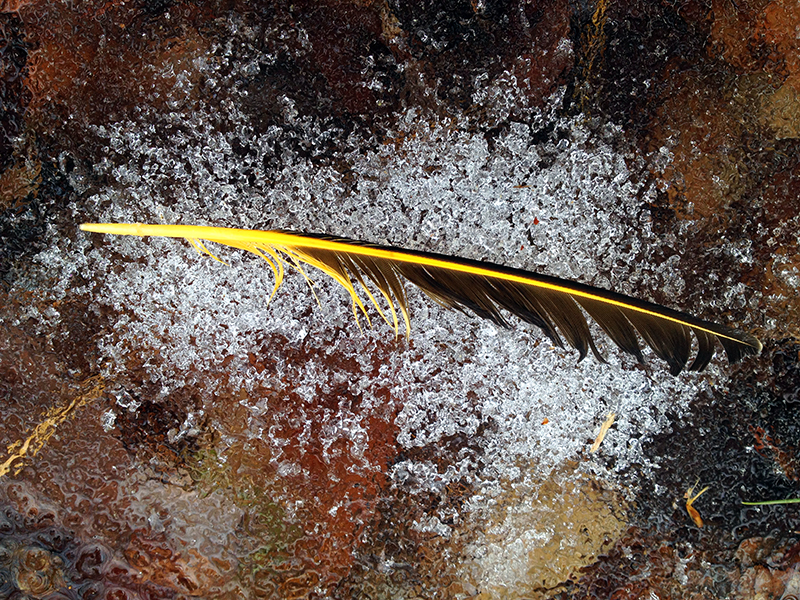
I spotted real treasure today with this small yellow feather. Despite being only about four inches long, against the brown leaves it stood out to me like a beacon. I tucked it into my pocket, to add to my collection, and once home identified it as a wing feather from a northern flicker.
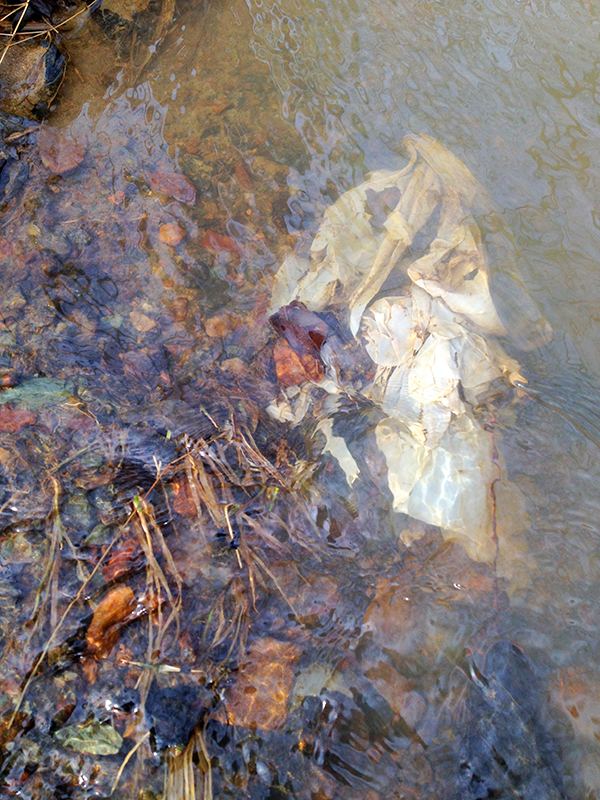
At some point I approached what I was sure was a horse-sized skull buried in the creek gravel. I got very excited, but turns out it was just a plastic bag. Seeing it brought to mind a hike I took up a creek in the Blue Ridge with friends the summer before I went to college. We got to a very tricky part that was basically just scrambling up a sheer rock face covered with rushing water. As I started to climb I slipped and fell backward into a pool of water, hitting my hip and injuring it for for what would turn out to be years to come. I was in great pain, but when I went to heave myself up I turned and saw that I’d splashed down right next to a dead dog, pale and decomposing in the water.
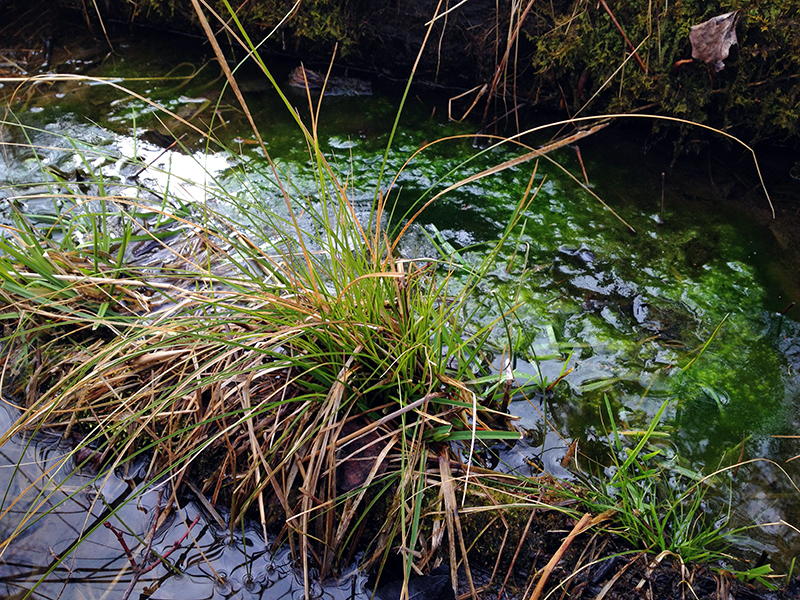
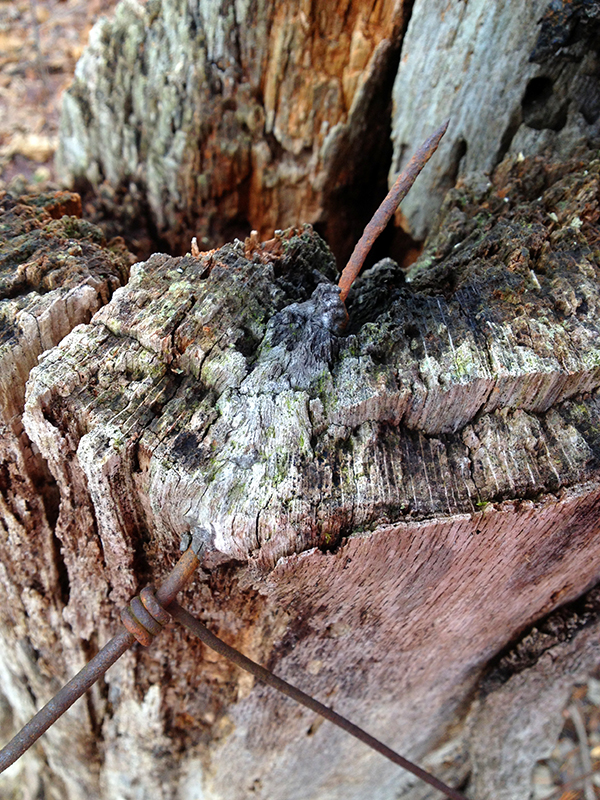
Maybe the winter colors of the creek really are all about death and decay. Regardless, or maybe because of this, I love this winter creek’s color palette best—when the water and leaves combine to give me new appreciation for a subtle layering of browns spiked with an occasional acid green, bone white or flicker gold. It takes work to seek out inspiration in winter, the season of sleeping rot, but each time I walk to the creek I find something beautiful.
February 19th, 2014 §
February 17th, 2014 §
I just came across this collection of photographs from a contest sponsored by the Royal Botanic Gardens, Kew, in England, and I have been mesmerized for a long time, taking in the details of each exquisite photo. I don’t reblog much, but these images are on par with anything I’ve seen come out of the National Geographic Photo Contest and deserve as much exposure as they can get. Maybe I’ll submit one of my own images to this contest some day—seeing these photos is real motivation to keep upping my own photographic game.
It’s easy to piece together some trends from this winning collection. Of course the New Perennials are still going strong, as evidenced by the contest winner, Rosanna Castrini, an Italian garden designer who describes her gorgeous garden as a prairie. Her photo, below, has reawakened my lust for Echinachea “Magnus,” a magenta coneflower (and 1998 Perennial Plant of the Year) that’s been on my radar for a few years but I’ve yet to encounter in any local garden center. Also still hot are representations, either natural or planted, of “meadows.”
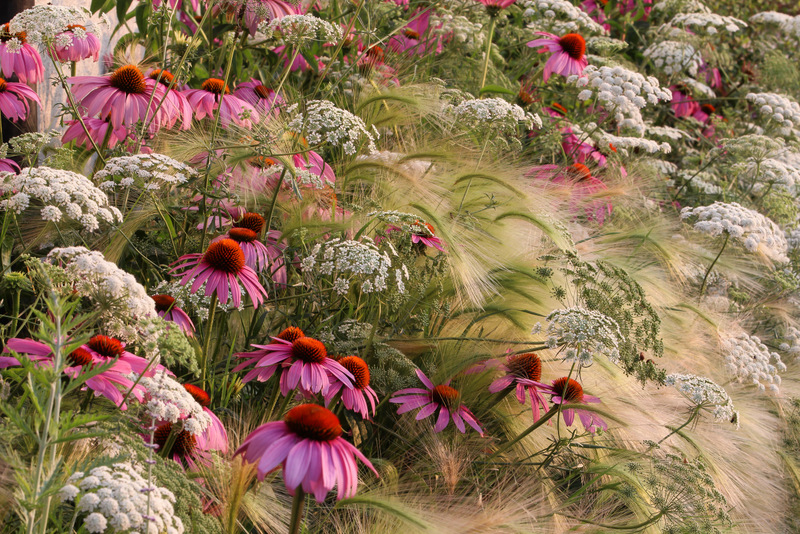
Take some time to click through and enlarge each of these images. At the very least you’ll find a break from the seemingly relentless cold and snow surrounding most of us. And at best, you’ll take away some inspiration for a future garden design.
February 14th, 2014 §
Around six tonight I suddenly remembered it was the eve of February’s full moon. I ran outside with my camera and tripod to get a few shots as it rose in the front yard over Buck Mountain. The moon’s light on all the snow made it so bright that within a few minutes of my eyes adjusting I could have walked anywhere I wished without any extra light.
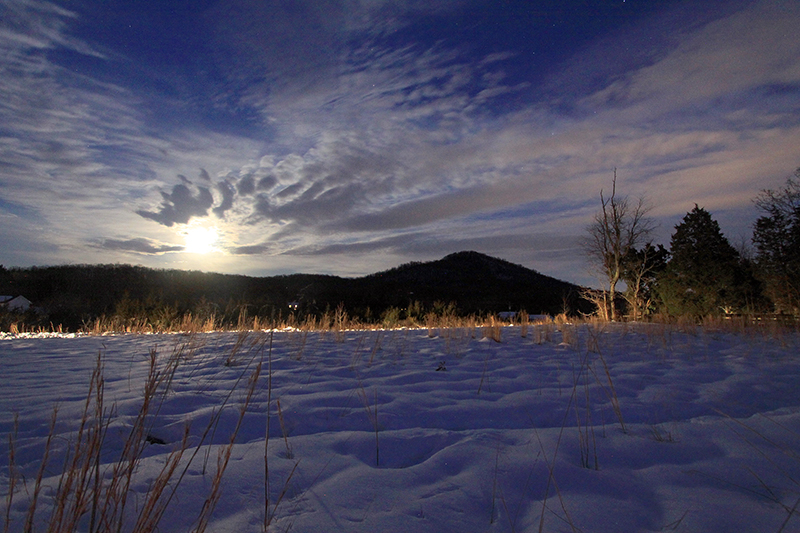
A far-away friend recently asked me if you could see any stars from my farm. Well, here’s your answer. Even on a full-moon night, the stars pop out of the sky.
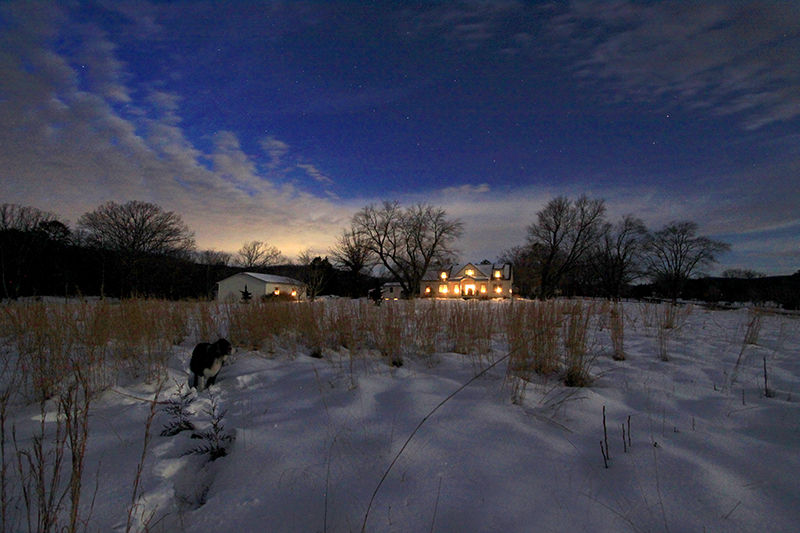
It’s nights like these that I’m again reminded why I like to leave the hay standing in the front field over winter, instead of bush hogging as most people do in fall. Not only does it create lots of habitat—the place is riddled with deer beds, and Tucker is constantly hunting voles and rabbits out here—it also makes a more interesting picture. And, I love the golden color of the standing grass. In the grey darkness of winter, I will take color anywhere I can get it.
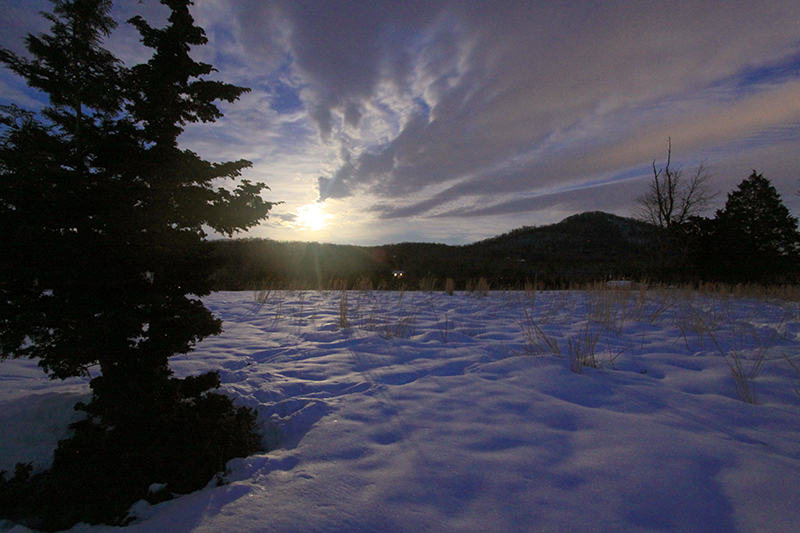
Full moon with Chamaecyparis obtusa, in foreground, and Juniperus virginiana, at far right. Cultivated and wild, planted by me and sown by birds, respectively.
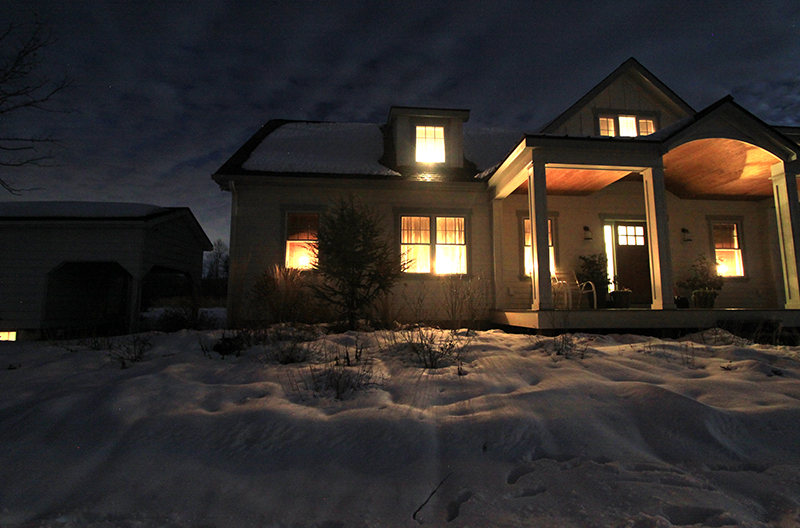
Winter garden, under 15″ of snow. I am loving the architecture of the rock wall beneath the snow, and how something so low and jagged has been smoothed into great pillows lining the bed.
There’s another little clipper system on the way, and even in the fifteen or so minutes I was out taking photos the clouds started to thicken and obscure the full moon. We’re supposed to pick up another inch or so of snow overnight, but next week temps are forecast to be in the 60s. Undoubtedly all the daffodils will be tricked into thinking it’s spring, only to be dumped on by the snow that always falls into March.
February 13th, 2014 §
The second wave of this big storm ended at dusk, and with just a bit of light left I went out with the dog to get some photos. I didn’t take an official measurement, but the snow came over the top of my wellies, which are 16″ tall. That’s a lot of snow, especially for here—the most since “Snowpocalypse” in 2009/2010, the winter I built my house. Tonight the national news reported that 60% of the U.S. is under snow. Impressive and wonderful, to have a real winter again.
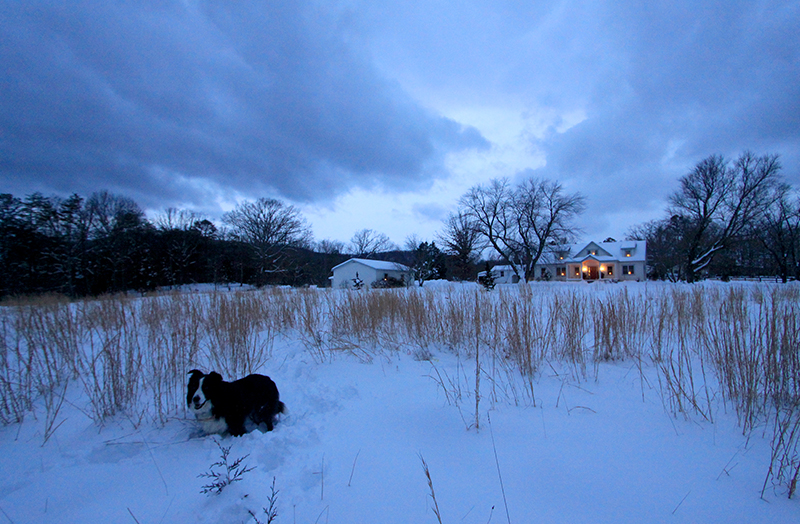
Being snowed in makes feel especially fondly toward my little farm, which gives me everything I need. Looking back on it from across the pasture, I can see the candles lit in the windows, a warm coop that shelters my flock, a great garage full of capable machines, a beautiful wood stove burning through the sidelights, and a black dog that’s happy to break any trail I need. I never expected to feel as in love with a place as I do here. It’s a feeling I looked for my entire life, and I am blessed to have created it. On the eve of Valentine’s Day, my love is right here.
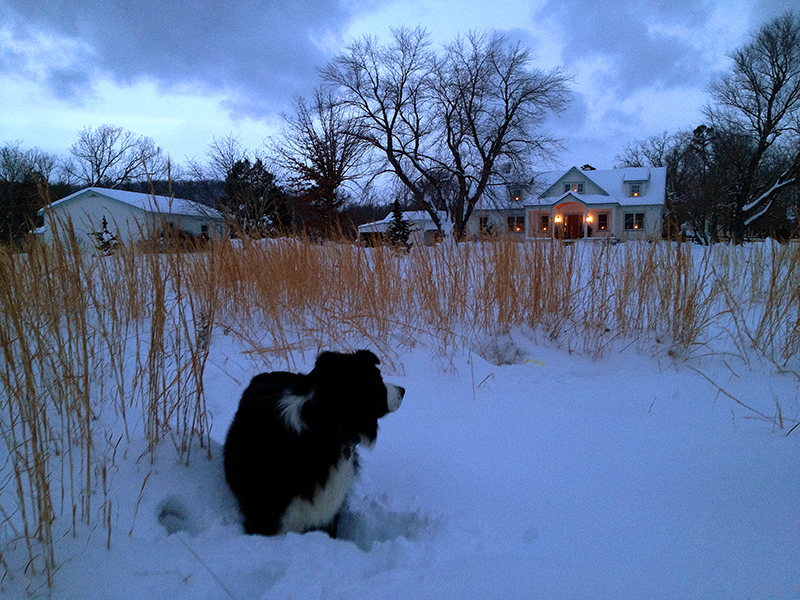
More snow photos to come, I imagine, in the morning.
February 13th, 2014 §
The winter storm that started trouble making in Texas is now upon Free Union and headed up the East coast. It started snowing last night just after 6:00 p.m., and at 9:00 this morning there were 13 inches on the ground and more still falling. This is a pretty significant snow event for our area.
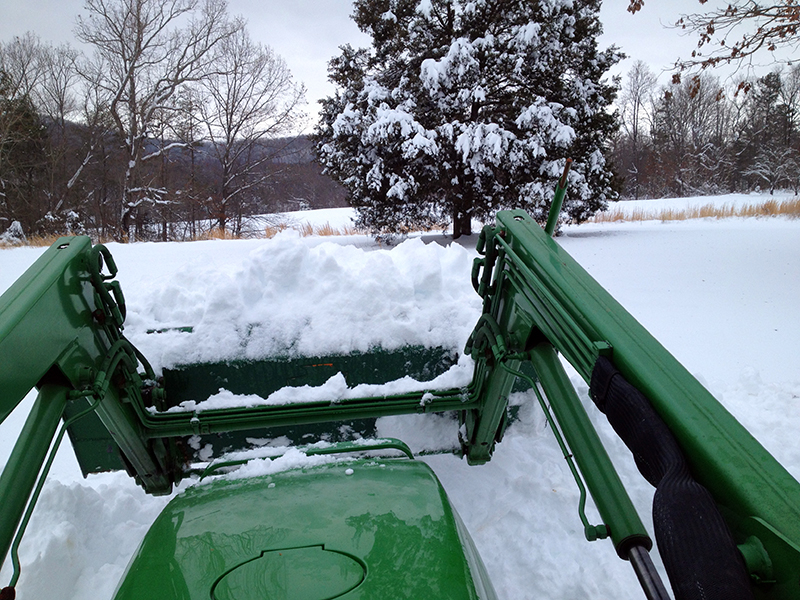
I ducked out in a break between snow bands to dig out the driveway. Yesterday I had staged the tractor, putting on the smaller bucket and moving equipment around in the garage so I could back the tractor in, ready to head out bucket first in the event of a big snow. Sometimes my storm preparations seem like overkill, as in Central Virginia snow events tend to bust more often than boom, but all the forecasters were saying this one was a sure thing. I didn’t want to be caught with my tractor trapped inside behind the zero-turn mower, sporting the wrong bucket for shoveling snow.
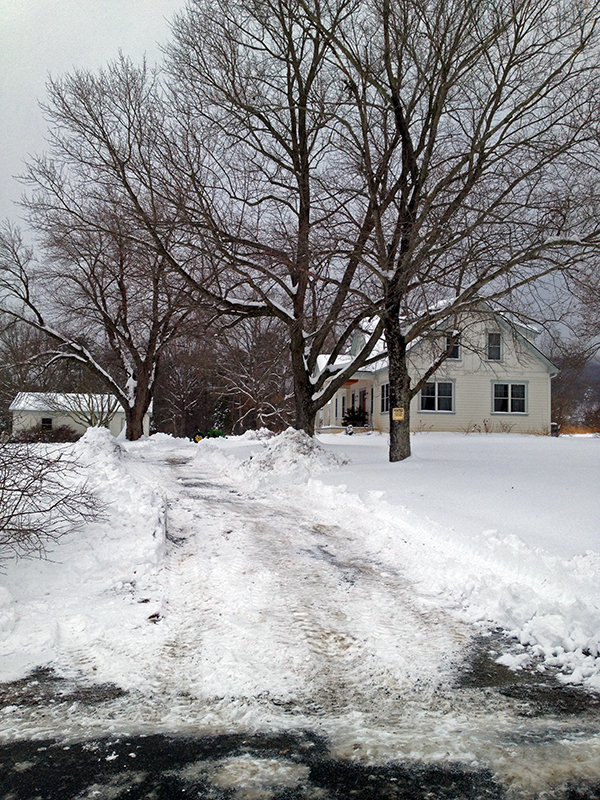
Using a tractor bucket instead of a snow plow is slow going. It took me about two hours to dig my way out of the garage and down the driveway toward the road, where I cleared the path to the mailbox for the mailman who probably won’t come for days. I worked pretty slowly, trying to preserve what little gravel I have on the driveway. I thought it was interesting that I was the only person out clearing anything—my neighbor was snowboarding down the road with his three teenage kids!
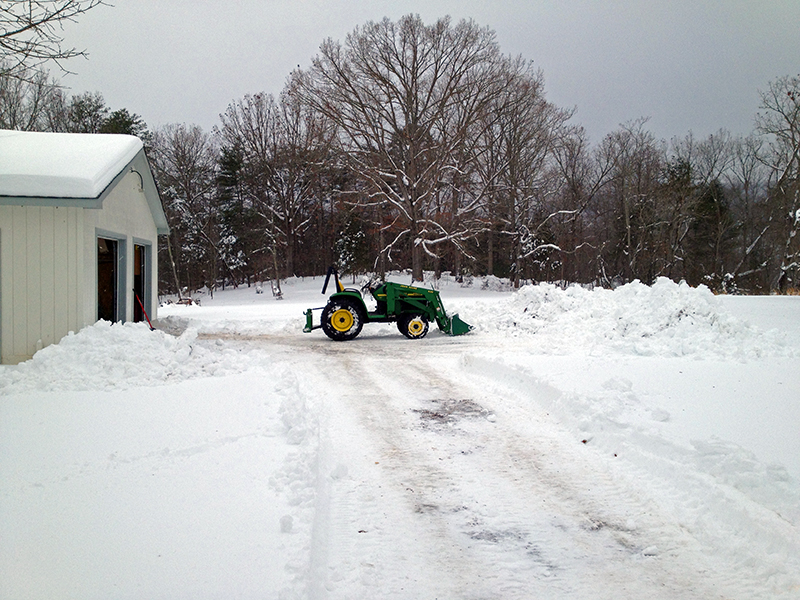
I often mention on this blog how much I love my green tractor, and today was no exception as that tractor meant the difference between being trapped in the mountains and not, once the main road is plowed. I felt like a Carhartt-clad snow queen in her chariot, enjoying the slack-jawed gaping of the few country neighbors who slid by in their pick-ups.
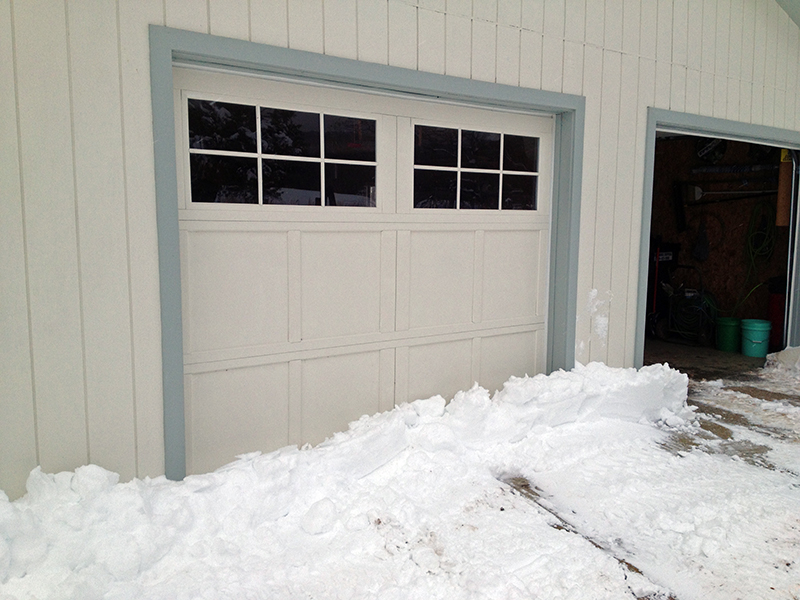
I had only a tiny bit of shovel work right in front of the garage on the side where my car is parked. Once I was done I checked on the chickens, filled up the very-popular bird feeders and headed inside to the woodstove and a cup of hot tea, just as the next round of heavy snow began to come down.
We’re supposed to get a few more inches of wet and heavy snow tonight, and the winds are really picking up and blowing into near white-out conditions—certainly working to undo this afternoon’s plowing. High winds mean the power may go out, so I’ll hit publish while I still can. But at least I have my driveway plowed enough to get out with my S.U.V.
Now, when the fifteen miles into town are a bit more clear, I could actually go somewhere!
January 24th, 2014 §
It was nine degrees here when I got home last night, and the week-old snow is still so dry and fluffy that it squeaks under my boots. I have the wood stove running nonstop to keep the auxiliary heat from engaging, especially after I just read that it costs 2-5 times the cost of the regular electric heat to run. And yet, when I called every Tractor Supply within a 100-mile radius I was told that their winter work gloves are all out of stock, and out of season.
Seriously? It doesn’t even take a calendar to know that we’ve still got at least two more months of winter glove-wearing weather ahead of us.
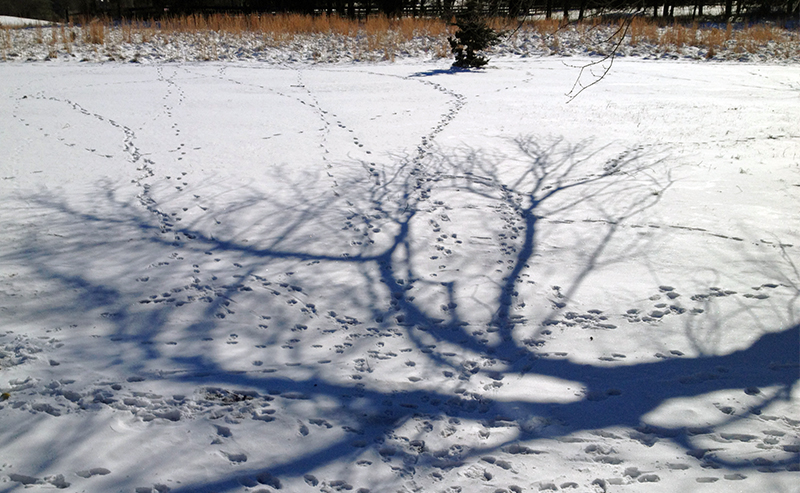
I got my Thinsulate-lined leather work gloves when I was living in Alaska, where the glove display at the local roughneck emporium took up an entire long wall. It’s really hard to find good gloves that fit a lady’s hand, well, like a glove, and I fell in love with this pair. They’ve become my favorite wood-splitting and stove-tending gloves, but I loved them a little hard last winter doing tree work. Now they’ve got a hole in the fingertip that’s rather inconvenient when tending a 600-degree chunk of metal.
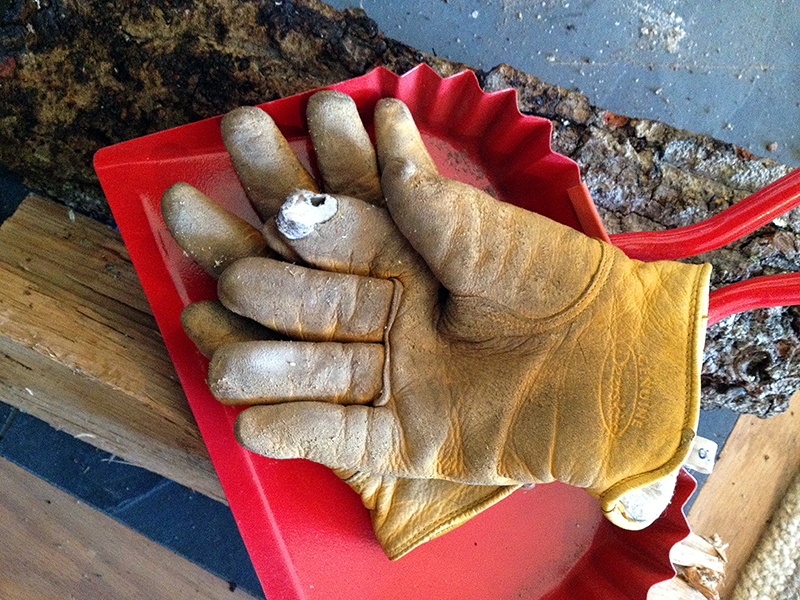
I guess it’s time to go tan a hide and patch my gloves. Then hopefully next summer I will be able to buy a new pair of winter work gloves, because then, you know, they’ll be in season. I’ll wear them with my bikini.
January 22nd, 2014 §
Snowplows are rumbling outside my window, the white stuff’s still coming down, and temps are cold enough to warrant a red-light district in the chicken coop. Sounds like a great time to revisit England in July, this time to the Royal Botanic Gardens, Kew—a must-see spot on any gardener’s tour of England.
Kew was founded in 1759 and declared a UNESCO World Heritage Site in 2003. I thought that seemed pretty old until I looked up the world’s oldest botanical garden, which is in Padua, Italy and was created in 1545. The Padua garden is also a World Heritage Site, according the UNESCO, “considering that the Botanical Garden of Padua is the original of all botanical gardens throughout the world, and represents the birth of science, of scientific exchanges, and understanding of the relationship between nature and culture. It has made a profound contribution to the development of many modern scientific disciplines, notably botany, medicine, chemistry, ecology, and pharmacy.” Most people don’t immediately think of all these far-reaching implications of gardening, but there you have it, and it’s all true.
But that’s enough trivia—we came here to see Kew, and Padua will just have to join the very long list of gardens yet to be visited. In addition to being a top London tourist attraction, Kew is also a research institution for plant science and conservation. I can’t speak to any sort of research that’s happening at Kew, and can only appreciate it as a gardener. It’s definitely impressive, and huge, and though I’ve visited it twice on separate trips to England, I am sure there is still more to see. Far be it from me to cover it all in a couple of posts, so I will just focus on the areas most interesting to me.
In addition to giant, Victorian-era glasshouses that house palms and tropicals, there are a few more modern structures:

The structure above, to the left, is the newest glasshouse and one of my favorites. It’s the Davies Apline House, a rock garden full of all sorts of tiny little plants—most of them seeming Mediterranean in origin. I love how these small plants are basically served up on rocky platters, brought close for use to appreciate them in detail and in pleasing contrast to their rocky ledges. Can you believe that four full-time staff and one trainee are dedicated to the care of this glasshouse, which isn’t much larger than what you see in the photo? That is wonderful to me—so many talents and resources dedicated to such tiny plants in a little space.
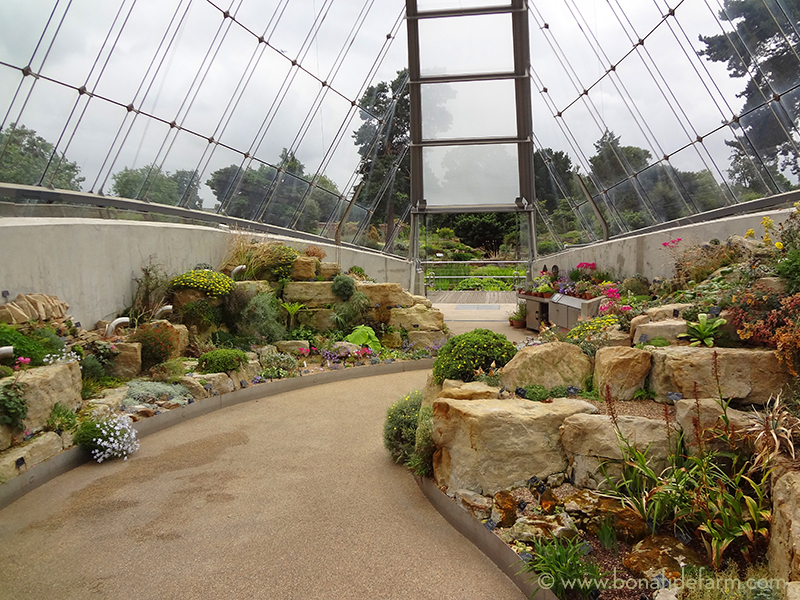
It was in this display that I found a spectacular oregano, Origanum amanum, from Turkey. It’s similar to a hybrid ornamental I grow in my own garden, Origanum “Kent Beauty.” The blue flower in the photo is some sort of bell flower.
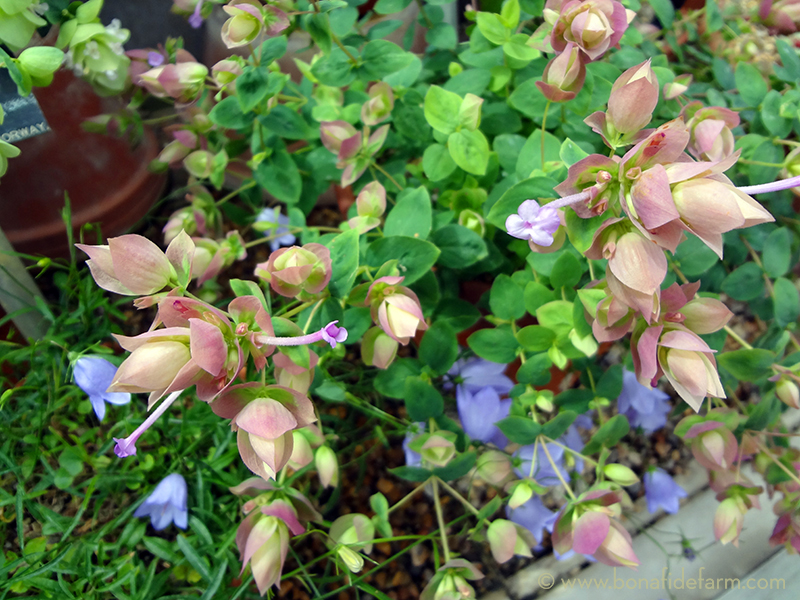
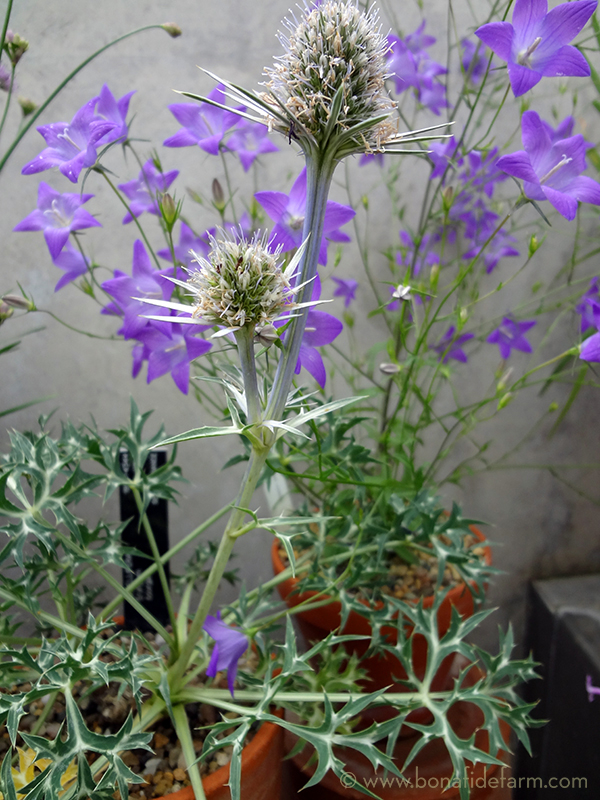
Just outside this glasshouse is an outdoor rock garden, which is one of my favorite areas of Kew. What I like about it, again, is how the rocks form a stage that elevate into the spotlight small and perhaps easily overlooked plants.
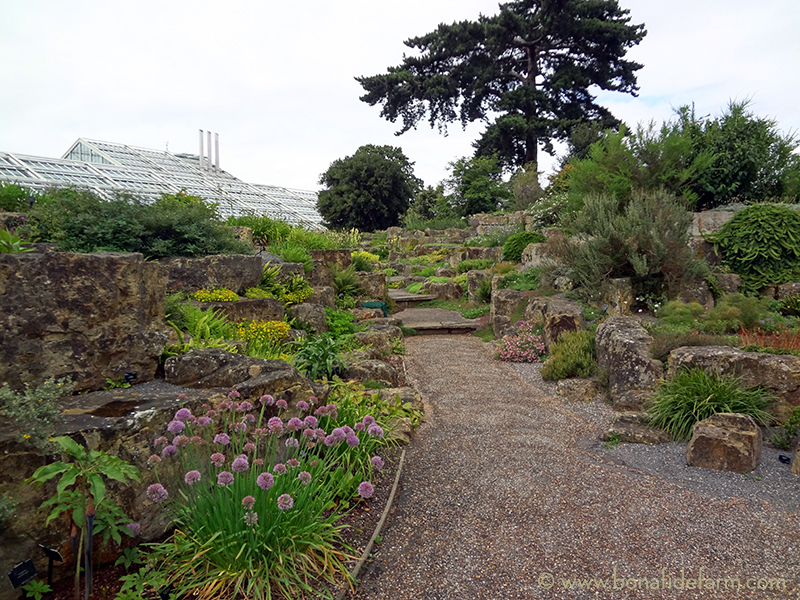
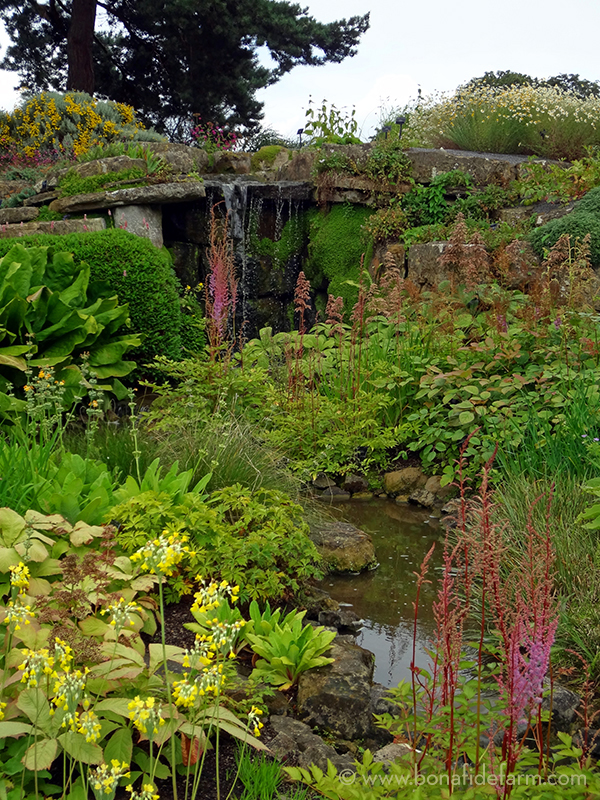
Near this area is a series of great meadows planted with all sorts of grasses. I love the painterly effect of their intermingling, and that they would be relatively low maintenance. This is definitely an idea I’d like to try somewhere on my own property—once I can get past the on-the-surface foolishness of replacing a perfectly good natural meadow with a cultivated one!
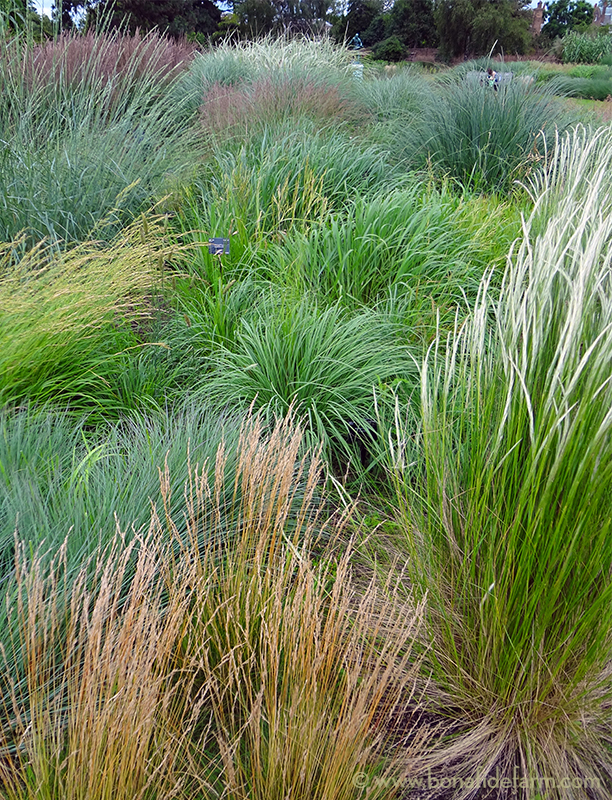
I won’t focus too much on the glasshouses, as I found them to be the least interesting part of Kew. They’re neat in that they’re old, and have lots of peeling-white-paint patina, but the plantings inside them just weren’t as interesting to me as what was going on outside. Perhaps that’s because I approach every garden visit with an eye toward what I can appropriate for Bonafide Farm, and a greenhouse full of tropicals just isn’t in my future. Although, funnily enough, my neighbors opened a winery centered on a giant greenhouse full of tropicals, so it’s certainly possible right in this mountainous little valley in Central Virginia.
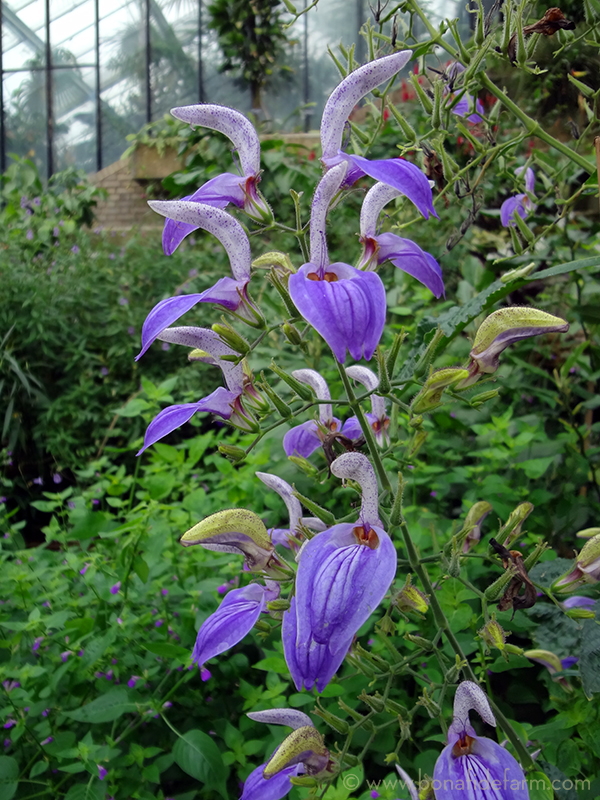
I couldn’t resist, however, this flowering vine growing in one of the glasshouses. I know not what it is, but isn’t it exquisite? If you can i.d. it, tell me in the comments, please!
Up next in part two, walking the grounds of Kew, and getting some wood with the sculptor David Nash.
January 20th, 2014 §
All that pottering in the garden yesterday was barely enough to keep me warm. To get the blood flowing I split some kindling, enough to get a few more wood stove fires going. I tore into a few rounds of of choke cherry cut this time last year when I cleared my wood line. It felt really good to split this beautiful red wood that I knew when it was still a living tree, festooned with honeysuckle and girded with wild brambles.
I was heavily supervised by the quality control team, which didn’t seem too perturbed when an errant piece of cherry clocked one of them in the head. That Griz (rooster, lower right) really keeps an eye on everything. He’s a personable rooster if I ever saw one—maybe because as an embryo he was rescued from a refrigerator and I held him in my hand within seconds of him kicking free of his eggshell?
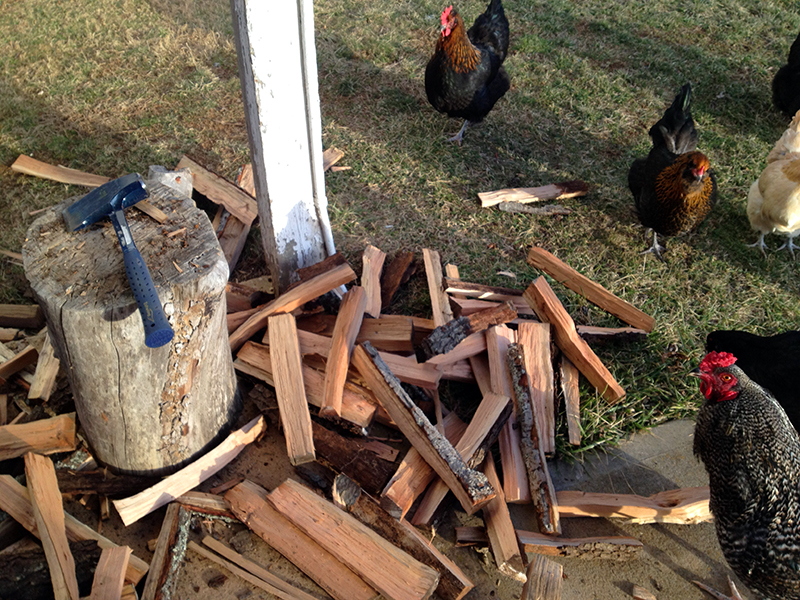
That makes me think of one of the most unexpectedly wonderful, and sometimes heartbreaking, aspects of this whole farm life. Whether it’s working to turn a living tree into fuel to heat my house or raising generations of homegrown chickens, it is beautiful to see cycles, and lifecycles, complete themselves under my watch.
I started stacking the kindling and this one, my English shadow, maneuvered himself right into portrait position and smiled for the camera with no direction from me. The Cora photobomb was similarly unscripted.
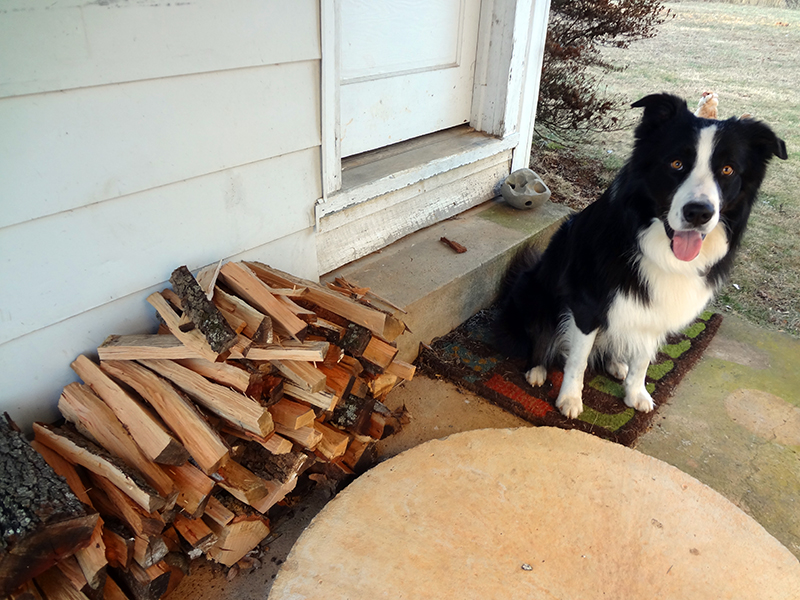
Speaking of Cora, she’s another country heard from with yesterday’s egg collection. Along with two small green eggs, and one large brown Dahlia egg, I found a pointy blue egg that could only have come from Cora. It’s one of less than ten that she’s ever laid in her life, which makes each of her eggs worth probably $100 when you figure in the cost of feed. If I hadn’t felt this little dear die and resurrect under my fingers, if I hadn’t become intimately acquainted with every muscle and vein of her skinless head as I fought to keep infection and fly infestation at bay, she would have long been Craigslisted by now.
But Cora still here, and once in a blue moon she lays a pointy turquoise egg. To my appreciation and great delight.
